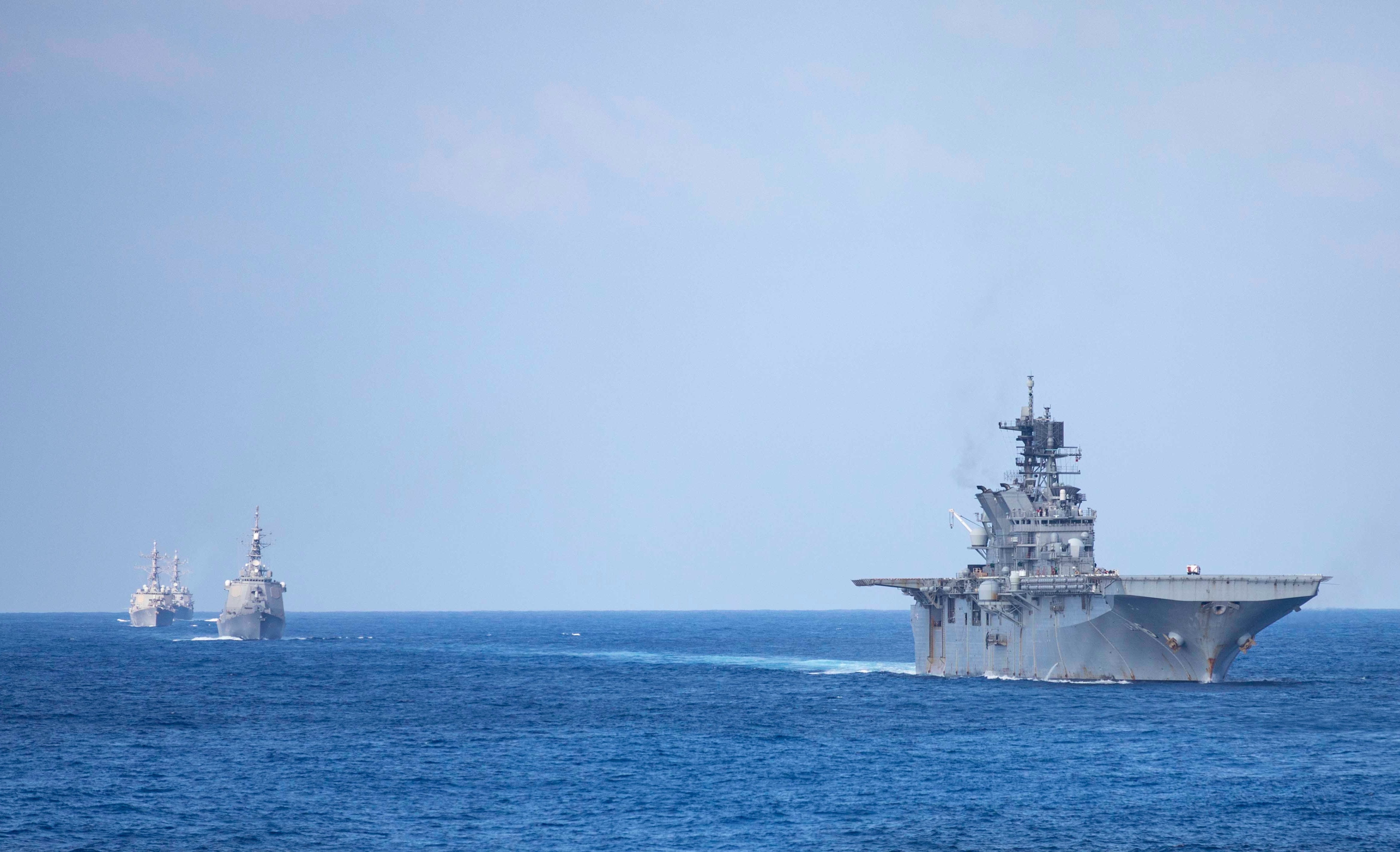
Big deck amphib USS America (LHA-6), other U.S. Navy ships, and a submarine wrapped up the Surface Warfare Advanced Tactical Training 24 drill with the Japan Maritime Self Defense Force (JMSDF) in the Philippine Sea on Saturday.
America, along with destroyers USS Dewey (DDG-105), USS Higgins (DDG-76), USS Howard (DDG-83) and USS Ralph Johnson (DDG-114), fleet oiler USNS Yukon (T-AO-202) and a submarine conducted drills with JMSDF destroyer JS Kongo (DDG-173) from Mar. 18 until Saturday, a Monday JMSDF release reads. The drill included a harbor phase in Yokosuka from Mar. 18-21, followed by a sea phase on Mar. 22 until Saturday, which took from Yokosuka to east of Okinawa, according to the release.
The sea phase consisted of tactical exercises such as antiair warfare, antisubmarine warfare, surface gunnery exercises, electronic warfare, antiair missile firing and replenishment at sea. The release also stated that this was the first bilateral exercise carried out in Japan’s Fiscal Year 2024, which began on April 1.
In a second JMSDF release, Kongo’s commanding officer, Capt. Gen Kawai said, “JS Kongo has confirmed the strong Japan-U.S. collaboration and improved tactical capabilities and interoperability between the JMSDF and the U.S. Navy through practical exercises such as missile firing, which are more high-end than those in recent years.” He added that “although the security environment surrounding Japan is becoming increasingly severe day by day, we will continue to pursue missions at hand and contribute to the stability of Japan and the Indo-Pacific region.”
The four U.S. destroyers are part of the forward-deployed Japan Destroyer Squadron (DESRON) 15, and on Friday, Higgins, Howard and Ralph Johnson conducted live-fire launches of SM-2 surface-to-air missiles in the Philippine Sea, with dry cargo ship USNS Charles Drew (T-AKE-10) launching target drones for the drill, based on released photos by the Pentagon.
Meanwhile, Russian bombers made separate flights over the Sea of Japan and the Chukchi Sea over the past week. A Japan Joint Staff Office (JSO) release on Wednesday stated that on Tuesday afternoon, two Russian Tu-95 bombers and two Russian fighter aircraft flew in from the continent on a southeast heading toward Japan before turning back northwest while in international airspace off the Noto Peninsula on the main island of Honshu. Japan Air Self-Defense Force fighters were scrambled in response, stated the JSO release.
A Russian Ministry of Defense (MOD) release the same day stated that two Tu-95ms long-range bombers made a routine flight over the international waters of the Sea of Japan and that the flight duration was about 10 hours, with fighter escort provided by the crews of Su-30sm fighters of the Russian Aerospace Forces.
On Friday, the North American Aerospace Defence Command (NORAD) issued a release stating the command had detected and tracked four Russian military aircraft operating in the Alaska Air Defense Identification Zone (ADIZ) on that day. “The Russian aircraft remained in international airspace and did not enter American or Canadian sovereign airspace, this Russian activity in the Alaska ADIZ occurs regularly and is not seen as a threat,” read the release.
The Russian MOD also issued a release on the flight stating that two Tu-95ms long-range bombers of the Russian Aerospace Forces made a routine flight over the international waters of the Chukchi Sea and that the flight duration was more than 12 hours. The release also stated that the Su-35sm fighter jets escorted the long-range bomber and that at certain stages of the route, long-range bombers were escorted by fighter jets of foreign countries.
Both Russian MOD releases included a statement from the commander of Long-Range Air Force Lt. Gen. Sergey Kobylash. “The flight was carried out in strict compliance with international rules on the use of airspace,” said Kobylash who also stressed that “Long-Range Aviation crews regularly fly over the international waters of the Arctic, North Atlantic, Black and Baltic seas, as well as the Pacific Ocean.”
Japan’s JSO also issued releases over the past week on the activity of Chinese and Russian surveillance ships around Japan. On Wednesday, the JSO issued a release stating that at 10 a.m. on Tuesday, People’s Liberation Army Navy Dongdiao-class surveillance ship Jinxing (799) was sighted sailing southwest in an area 37 miles east of Tsushima and subsequently sailed southwest through the Tsushima Strait to enter the East China Sea. JMSDF fast-attack craft JS Otaka (PG-826) and and P-1 MPAs of Fleet Air Wing 4 based at Naval Air Facility Atsugi shadowed Jinxing, according to the release which also stated that earlier on Mar. 15, Jinxing sailed northeast through the Tsushima Strait to enter the Sea of Japan.
A Thursday JSO release stated that on April 1 at 11 p.m., Russian surveillance ship Kareliya (535) was sighted sailing south in an area 24 miles northeast of Miyako Island and from Apr. 1 to Tuesday, sailed in the contiguous zone from northeast of Miyako Island to southeast of Hateruma Island before departing from the contiguous zone south of Hateruma Island. A contiguous zone is a band of water up to 12 miles from territorial waters in which states have limited jurisdiction to prevent or punish infringement of its customs, fiscal, immigration or sanitary laws and regulations. As such, the passage of the Russian ship was within international law. The JSO stated that fleet oiler JS Oumi (AOE-426) and JMSDF P-3C Orion maritime patrol aircraft of Fleet Air Wing 5 based at Naha Air Base, Okinawa, shadowed the Russian ship. The release also noted the past movements of Kareliya, which has been sailing around Japan since Mar. 24.





